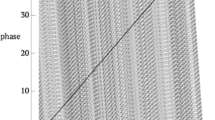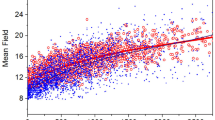Abstract
MEASUREMENTS of the general (polar) magnetic field of the Sun1 show that since September 1964 the Sun has behaved on average like a dipole with a negative field strength at the North Pole and an approximately equal positive field at the South Pole (the mean ranging from 0.5 to 1.0 G). But because of a bias toward the area of the negative polarity in the northern hemisphere, the net magnetic flux was on average negative most of the time; in this sense the Sun behaved like a “monopole”. There were large deviations from the mean, however; for example, sometimes both poles had a field of the same sign (in February–April 1965), and during the first half of 1964 the mean strength at the South Pole was zero.
Similar content being viewed by others
References
Severny, A. B., Izvest. Krim. Astrofiz. Obs., 35, 97 (1966); 38, 3 (1967).
Severny, A. B., Izvest. Krim. Astrofiz. Obs., 15, 31 (1955).
Bumba, V., and Howard, R., Astrophys. J., 141, 1502 (1965).
Severny, A. B., Vistas in Astronomy (in the press).
Wilcox, J. M., and Howard, R., Solar Phys., 5, 564 (1968).
Dodson, H. W., and Hedeman, E. R., IAU Symp. No.35 Structure and Development of Solar Active Regions, 56 (D. Reidel Pub. Co., 1968).
Author information
Authors and Affiliations
Rights and permissions
About this article
Cite this article
SEVERNY, A. Is the Sun a Magnetic Rotator?. Nature 224, 53–54 (1969). https://doi.org/10.1038/224053a0
Received:
Issue Date:
DOI: https://doi.org/10.1038/224053a0
- Springer Nature Limited
This article is cited by
-
Rotation of the Solar Equator
Solar Physics (2017)
-
Solar 22 years cycle
Astrophysics and Space Science (2017)
-
Using SDO/HMI Magnetograms as a Source of the Solar Mean Magnetic Field Data
Solar Physics (2016)
-
On the Near-One-Year Variation of the Sun’s Mean Magnetic Field
Solar Physics (2006)
-
Zero-level problem of solar magnetographs and observations of large-scale magnetic fields
Radiophysics and Quantum Electronics (1996)





